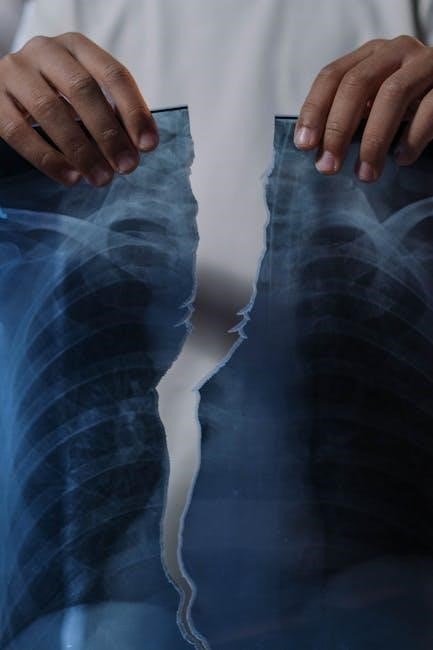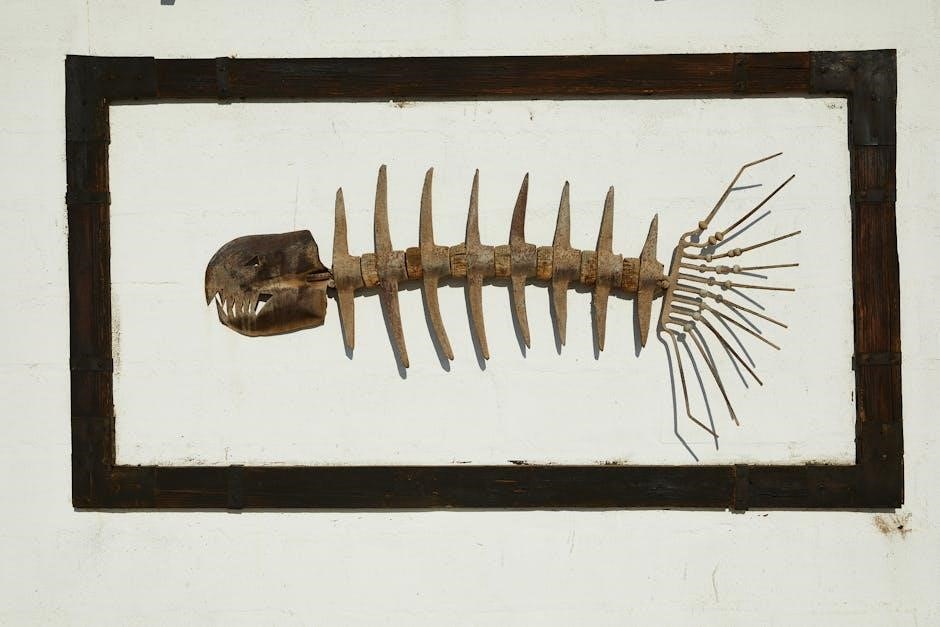Bone fractures are breaks in bone tissue‚ ranging from minor cracks to severe disruptions. They often result from trauma‚ falls‚ or conditions like osteoporosis. Understanding fracture types is crucial for effective treatment and recovery.
1.1 Definition and Overview
A bone fracture is a medical term for a broken bone‚ occurring when there is a partial or complete break in the continuity of bone tissue. Fractures can result from trauma‚ falls‚ or conditions like osteoporosis‚ which weaken bones. Understanding the definition and overview of fractures is essential for proper diagnosis‚ treatment‚ and rehabilitation‚ ensuring optimal recovery and bone health.
1.2 Importance of Understanding Fracture Types
Understanding bone fracture types is crucial for accurate diagnosis‚ treatment‚ and recovery. Different fractures require specialized approaches‚ and recognizing their characteristics helps in developing personalized treatment plans. This knowledge also aids in preventing complications and improving patient outcomes‚ making it essential for healthcare providers and patients alike to grasp the nuances of fracture classification.
Classification of Bone Fractures
Bone fractures are classified based on openness‚ completeness‚ location‚ and pattern. This system helps in determining the severity and appropriate treatment approach for each fracture type.
2.1 By Openness
Bone fractures are classified as open (compound) or closed (simple). Open fractures occur when the bone pierces the skin‚ increasing infection risk. Closed fractures remain beneath the skin‚ reducing infection chances. This classification aids in determining treatment urgency and the need for surgical intervention to prevent complications.
2.2 By Completeness
Bone fractures can be partial or complete. Partial fractures involve an incomplete break‚ where the bone remains aligned. Complete fractures result in two separate bone segments. This classification helps determine the severity and appropriate treatment‚ ensuring proper alignment and healing. It is crucial for developing effective recovery plans.
2.3 By Location
Bone fractures are also classified by their location within the bone‚ such as shaft fractures (occurring in the long‚ cylindrical part of the bone) or fractures near the joints. Fractures in the metaphysis (the wider portion near the joint) or epiphysis (the end of the bone) are common. The location often influences treatment options and recovery timelines‚ ensuring proper alignment and function.
2.4 By Pattern
Bone fractures can be classified by their pattern‚ such as transverse (straight across the bone)‚ oblique (diagonal)‚ spiral (twisting around the bone)‚ or comminuted (bone breaks into multiple pieces). These patterns result from different injury mechanisms‚ like direct blows or twisting forces. Understanding the fracture pattern helps determine the severity and appropriate treatment‚ guiding both surgical and non-surgical interventions effectively.
Common Types of Bone Fractures
This section explores the most common types of bone fractures‚ including transverse‚ oblique‚ comminuted‚ and spiral fractures‚ each with distinct characteristics and treatment approaches.
3.1 Transverse Fractures
Transverse fractures are straight breaks across the bone‚ often caused by bending stresses. They appear as clean‚ right-angled cracks‚ making them easier to diagnose. These fractures are more common in osteoporotic or weakened bones‚ where the structure is more susceptible to stress. Generally stable‚ transverse fractures typically require immobilization and have a straightforward healing process compared to more complex breaks.
3.2 Oblique Fractures
Oblique fractures are slanted breaks across the bone‚ typically caused by twisting injuries or indirect force. The fracture line runs diagonally‚ creating an uneven edge. These fractures are often unstable and may require surgical intervention to ensure proper alignment and healing; Oblique fractures are less common than transverse but more complex due to their irregular pattern and potential for displacement.
3.3 Comminuted Fractures
Comminuted fractures involve the bone breaking into three or more fragments‚ often due to high-impact trauma. These fractures are complex‚ requiring precise alignment and stabilization‚ frequently through surgery. The irregular pieces can complicate healing‚ necessitating plates or screws for support. Recovery is challenging‚ with a higher risk of complications such as infection or improper healing if not managed effectively.
3.4 Spiral Fractures
Spiral fractures occur when a bone twists‚ creating a helical break. Common in sports or accidents involving twisting forces‚ they often affect long bones like the tibia or femur. Treatment may involve casting or surgery‚ depending on severity. Healing time varies‚ but proper immobilization and rehabilitation are crucial to restore function and prevent complications.
Specialized Fracture Types
Specialized fractures include unique types like greenstick‚ stress‚ avulsion‚ and compression fractures. Each has distinct causes and characteristics‚ requiring tailored diagnosis and treatment approaches for optimal recovery.
4.1 Greenstick Fractures
Greenstick fractures occur when a bone bends and partially breaks‚ common in children due to flexible bones. They often result from twisting injuries and typically require immobilization with a cast to heal properly. This type of fracture is less severe than a complete break and often responds well to conservative treatment.
4.2 Stress Fractures
Stress fractures are small cracks in bones caused by repetitive stress or overuse‚ often seen in athletes. Unlike acute injuries‚ they develop gradually due to activities like running or jumping. Common in weight-bearing bones‚ these fractures require early diagnosis to prevent progression. Treatment typically involves rest‚ physical therapy‚ and avoiding high-impact activities to promote healing and prevent further damage.
4.3 Avulsion Fractures
An avulsion fracture occurs when a fragment of bone is pulled away by a tendon or ligament during a traumatic injury or sudden movement. Common in areas like the pelvis or ankle‚ these fractures often result from sports injuries or falls. Early diagnosis and treatment are essential to restore function and prevent complications‚ typically involving immobilization or surgery.
4.4 Compression Fractures
A compression fracture occurs when a bone collapses under pressure‚ often in the spine. Common in osteoporosis‚ these fractures can result from minor falls or heavy lifting. Symptoms include sudden back pain and loss of height. Early treatment is crucial to prevent further complications‚ such as kyphosis‚ and to improve mobility and quality of life.

Fractures in Children
Children’s fractures differ due to flexible bones and growth plates. Common causes include falls and accidents. Proper treatment is crucial to prevent long-term growth complications.
5.1 Unique Aspects of Pediatric Fractures
Children’s bones are more flexible‚ leading to unique fracture types like greenstick fractures‚ where bones bend and partially break. Growth plate injuries are also common‚ potentially affecting future growth. Pediatric fractures often require specialized treatment to ensure proper healing and prevent long-term complications‚ emphasizing the importance of early and accurate diagnosis.
5.2 Growth Plate Fractures
Growth plate fractures occur in the cartilage areas of bones in children‚ potentially disrupting future growth. These injuries are classified into types like Salter-Harris fractures. Proper treatment is essential to prevent growth disturbances. Prompt medical intervention ensures normal bone development and function‚ avoiding long-term complications. Timely care is crucial for optimal recovery in pediatric cases.

Causes and Risk Factors
Bone fractures are often caused by traumatic injuries‚ osteoporosis‚ or repetitive stress. Risk factors include weak bones‚ poor nutrition‚ and high-impact activities. Prevention is key.
6.1 Traumatic Injuries
Traumatic injuries are a leading cause of bone fractures‚ often resulting from accidents‚ falls‚ or high-impact sports. These injuries can cause sudden‚ severe stress on bones‚ leading to breaks. Examples include fractures from car accidents‚ falls from heights‚ or direct blows. The severity varies‚ ranging from minor cracks to complex‚ displaced fractures requiring immediate medical attention.
6.2 Osteoporosis and Brittle Bones
Osteoporosis weakens bones‚ making them more susceptible to fractures. Brittle bones fracture easily‚ even from minor falls or stress. This condition often affects older adults‚ leading to fragility fractures‚ such as hip or vertebral fractures. Low bone density is a key factor‚ emphasizing the importance of preventive measures like diet and exercise to maintain bone health.
6.3 Repetitive Stress and Overuse
Repetitive stress and overuse can lead to fractures‚ often seen in athletes or individuals with repetitive jobs. Activities like running or jumping cause micro-fractures in bones‚ which can progress to full fractures if not addressed. Stress fractures are common in weight-bearing bones‚ highlighting the need for rest and proper training to prevent such injuries.

Diagnosis and Assessment
Diagnosis involves imaging techniques like X-rays and MRIs to visualize bone damage. Physical exams assess pain‚ swelling‚ and mobility to confirm fractures and guide treatment plans effectively.
7.1 Imaging Techniques
Imaging techniques like X-rays‚ MRIs‚ and CT scans are crucial for diagnosing fractures. X-rays provide clear bone images‚ while MRIs detect soft tissue damage. CT scans offer detailed cross-sectional views‚ helping assess complex fractures. Bone density scans evaluate osteoporosis risks‚ guiding treatment for fragile bones. These tools aid in accurately identifying fracture types and severity‚ ensuring proper treatment plans.
7.2 Physical Examination
A physical exam is essential for diagnosing fractures. It involves visual inspection for deformities‚ swelling‚ or bruising. Palpation helps identify tenderness or abnormal mobility. Assessing range of motion and neurological function ensures no nerve damage. These findings‚ combined with imaging‚ confirm fracture type and severity‚ guiding appropriate treatment plans.
Treatment Options
Bone fractures are treated non-surgically with casts or braces and surgically with internal fixation. The choice depends on the fracture type‚ severity‚ and patient’s overall condition.
8.1 Non-Surgical Methods
Non-surgical methods include casting‚ bracing‚ or splinting to immobilize and align bones‚ preventing further injury and promoting natural healing. Ideal for stable‚ non-displaced fractures‚ these techniques avoid surgery‚ reducing recovery time. Pain management and physical therapy often accompany them to restore strength and mobility‚ ensuring a full recovery without invasive procedures.
8.2 Surgical Interventions
Surgical interventions are required for complex or displaced fractures‚ where bones cannot heal properly without realignment. Techniques include internal fixation with plates‚ screws‚ or rods to stabilize fragments. Open fractures often necessitate surgery to clean and repair damage. Surgery restores alignment‚ promotes healing‚ and prevents complications‚ often followed by physical therapy to regain strength and mobility.

Recovery and Rehabilitation
Recovery involves immobilization‚ physical therapy‚ and gradual movement to restore strength and mobility. Proper rehabilitation ensures optimal healing and return to normal activities.
9.1 Immobilization and Casting
Immobilization is crucial for healing‚ often achieved through casting. Plaster or fiberglass casts encase the affected limb‚ preventing movement. Proper fit and care are essential to avoid complications. Duration varies depending on fracture severity and location. Additional immobilization methods include braces or splints for minor fractures. Strict adherence to medical advice ensures optimal bone alignment and healing.
9.2 Physical Therapy
Physical therapy plays a vital role in fracture recovery‚ focusing on restoring strength‚ mobility‚ and function. Customized exercises help improve range of motion and reduce stiffness. Therapy also addresses pain management and promotes proper healing. Consistent adherence to a structured program ensures optimal recovery and prevents long-term limitations. Early intervention enhances outcomes and accelerates return to normal activities.
Prevention Strategies
Preventing bone fractures involves a combination of regular exercise‚ a balanced diet rich in calcium and vitamin D‚ and avoiding hazards that could lead to falls.
10.1 Strengthening Bones
Strengthening bones through regular exercise and a balanced diet is essential for preventing fractures. Engaging in weight-bearing activities‚ like walking or jogging‚ and resistance training can improve bone density. Ensuring adequate calcium and vitamin D intake supports bone health. These practices help maintain strong bones and reduce the risk of fractures‚ especially in older adults or those with osteoporosis.
10.2 Avoiding Hazards
Avoiding hazards is crucial for preventing fractures. Remove tripping risks like loose rugs or clutter‚ ensure proper lighting‚ and use non-slip mats in bathrooms. Wear sturdy footwear and avoid walking on icy or uneven surfaces. Regularly inspect environments for potential dangers and take steps to eliminate them‚ reducing the likelihood of falls and fractures.
Bone fractures are common injuries requiring prompt care. Understanding types‚ causes‚ and treatments is vital for effective management. Prevention and proper medical attention ensure optimal recovery and bone health.
11.1 Summary of Key Points
Bone fractures are classified into stable‚ displaced‚ transverse‚ oblique‚ comminuted‚ spiral‚ greenstick‚ stress‚ avulsion‚ compression‚ and growth plate fractures. They result from trauma‚ osteoporosis‚ or repetitive stress. Understanding these types aids diagnosis and treatment. Timely care prevents complications. Treatments include immobilization or surgery‚ with recovery involving physical therapy. Prevention strategies‚ such as diet‚ exercise‚ and fall prevention‚ reduce fracture risk and promote bone health.
11.2 Final Thoughts on Bone Fracture Management
Effective bone fracture management requires a comprehensive approach‚ including early diagnosis‚ appropriate treatment‚ and rehabilitation. Preventive measures‚ such as strengthening bones and avoiding hazards‚ are key to reducing fracture risks. Patient commitment to recovery plans and maintaining bone health ensures optimal outcomes and long-term well-being.



